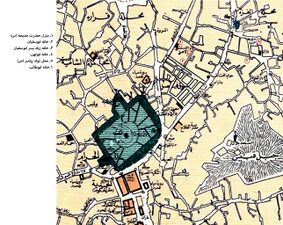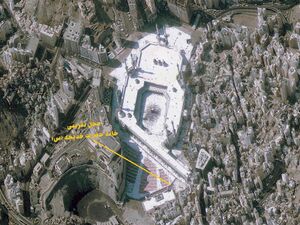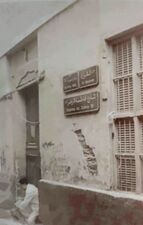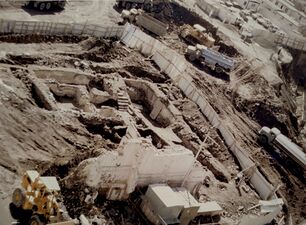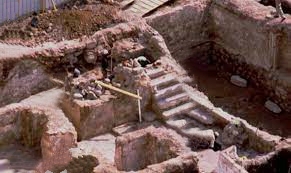Lady Khadija's House
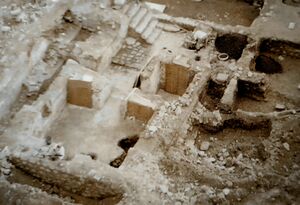 | |
| General Information | |
|---|---|
| Other Names | Mawlid Fatima |
| Place | Mecca, Zuqaq al-'Attarin |
| Religious Aspect | |
| Religious Affiliation | Islam, Shi'a |
| History | |
| Events | Revelation to the Prophet Muhammad(a), birth of Lady Fatima(a) |
| Current State | |
| Status | Destroyed |
Lady Khadija's House, (Arabic: دار السيدة خديجة, Dar al-Sayyida Khadija), in Mecca, was the house where the Prophet(s) lived after marrying Lady Khadija until he migrated to Medina. This house was the birthplace of Lady Fatima(a) and other children of Khadija, and many Meccan verses of the Quran were also revealed to the Prophet(s) in that house, and also Khadija died in this house. Since the 6th/12th century, this place has been also known in sources as Lady Fatima's birthplace. Since then, there has been two domes in this house. One was called Qubbat al-Wahy and it was built on a room that was considered the place of worship of the Prophet(s) and the place where Gabriel descended on the Prophet. The other dome was built over a room that was said to be Lady Fatima's birthplace.
In the 14th/20th century, after House of Saud conquered Mecca, this house was destroyed and later a building for teaching the Quran was built in its place. During the demolition and excavation of this place to develop al-Masjid al-Haram in 1410/1989, the remains of the old building of Khadija's house were found under the soil. This place has disappeared today and its location is in the area of al-Masjid al-Haram.
Location
Lady Khadija's house was in Perfumers Alley (Zuqaq al-'Attarin), Mecca.[1] It was located in the vicinity of Abu Sufyan's house.[2]
This house was the place where the Prophet(s) lived with Lady Khadija[3] and many Meccan verses of the Qur'an were revealed in this house.[4] Fatima(a) and other children of Lady Khadija were born in this house.[5] It is also reported that this house is the place of demise of Khadija. The Prophet(s) continued living in this house after that until he migrated to Medina.[6]
Names
This house became known as the Dar (house) of Lady Khadija because of her residence and it was also known as Lady Fatima's birthplace because of the birth of Lady Fatima there.[7]
First Descriptions
According to Abu l-Walid al-Azraqi, a historian of the third/ninth century, this house was taken over by 'Aqil b. Abi Talib after the Prophet(s) migrated to Medina. Mu'awiya b. Abi Sufyan bought the house and turned it into a mosque and opened a door to it from Abu Sufyan's house.[8] This house was later called Dar Abi Sufyan.[9] Elsewhere, al-Azraqi says that the house was occupied by Mu'attib, the son of Abu Lahab, one of the stubborn enemies of the Prophet(s) after his migration,[10] but the Prophet(s) did not claim the house after the conquest of Mecca.[11]
Ibn Jubayr (d. 614/1217-8) mentioned this house in his travelogue at the end of the 6th/12th century. This house had two domes at the time. The larger dome was called the Dome of the Revelation, which was the place where the Prophet(s) used to worship, and the place where Gabriel descended on the Prophet(s), and the other is a small dome, where Lady Fatima(a) was born.[12]
In the 9th/15th Century
Taqi al-Din al-Fasi (d. 832/1428-9), the historian of Mecca, gave a detailed description of the building of Khadija's house, or according to him "Mawlid Fatima", and pointed out that this house is considered virtuous by the people and they visit it.[13]
Al-Fasi says this place is more like a mosque because it has a portico with seven arches and eight columns. In the middle of the front wall are three altars; in front of it is a colonnade with four arches and five columns. The other part of the house is the rooms. One is Fatima's birthplace, the other is the Qubbat al-Wahy.[14] Some believe that these rooms are the old area house that was in the time of the Prophet(s) and the mosque was added to it later.[15] The shorter descriptions of other writers are also consistent with al-Fasi's description until the eleventh/seventeenth century.[16]
In the 13th/19th and 14th/20th century
In a travelogue from the end of the period of Nasir al-Din Shah Qajar (R. 1313-1264 AH), it is mentioned in the description of the house of Lady Khadija(s) that it had a marble floor, a dome was on Lady Fatima's birthplace and a room in it was called the place of the Prophet's worship.[17] According to a report in 1265/1849, in the place of Khadija's house, a takiyyah known as "Takiyyah al-Sayyida Fatima" was built for the use of the poor.[18]
Destruction
The Egyptian writer Mohammed Hussein Heikal (d. 1956) visited the place of this house in 1354/1936. He writes: Wahhabis have destroyed the birthplace of Lady Fatima(s) and now this place is an empty land and there is no trace of it.[19] Muhammad Lutfi Jum'a also confirms the destruction of the house in his travelogue.[20]
Construction of a School of the Quran
In Jumada I of 1370/1951, a building was built as a school of the Quran on the grounds of Lady Khadija's house.[21] Muhammad Tahir al-Kurdi (d. 1400/1980) has mentioned the building as takiyya.[22] The building was constructed by Sayyid 'Abbas Qattan and it was known as al-Sayyid 'Abbas's School in Umm al-Mu'minin Khadija's House.[23]
Merging with al-Masjid al-Haram
At the end of the year 1410/1989, the school of the Quran was destroyed for the eastern expansion of al-Masjid al-Haram. During the demolition operation, the remains of old building of Lady Khadija's house were excavated.[24] Ahmad Zaki al-Yamani, was present at the site during the operation and took pictures and maps of the remains of Lady Khadija's house and gave a report of his observations in his book Dar Sayyida Khadija bint Khuwaylid.[25]
Gallery
-
Location in the early Islam
-
After the latest expansion of the al-Masjid al-Haram
-
Al-Sayyid 'Abbas's school
Lady Khadijah's House Apearance During Destruction
Notes
- ↑ Azraqi, Akhbar Makka, vol. 2, p. 78-87; Yamani, Sayyida Khadija bint khuwaylid, p. 94.
- ↑ Azraqi, Akhbar Makka, vol. 2, p. 199.
- ↑ Azraqi, Akhbar Makka ,vol. 2, p. 199.
- ↑ al-fasi, al-Zuhur al-muqattifa min tarikh makka al-musharrifa, p. 99.
- ↑ Azraqi, Akhbar Makka ,vol. 2, p. 199.
- ↑ Azraqi, Akhbar Makka ,vol. 2, p. 199.
- ↑ al-fasi, al-Zuhur al-muqattifa min tarikh makka al-musharrifa, p. 99.
- ↑ Azraqi, Akhbar Makka, vol. 2, p. 199; Ibn Zahira, al-Jami' al-latif, p. 286; Kurdi,al-Tarikh al-qawim, vol. 1, p. 289.
- ↑ Kurdi,al-Tarikh al-qawim, vol. 1, p. 289.
- ↑ Ibn Sa'd,al-Tabaqat al-kubra vol. 4, p. 45.
- ↑ Azraqi, Akhbar Makka, vol. 2, p. 245.
- ↑ Ibn Jubayr, Safarnama Ibn Jubayr, p. 81-82.
- ↑ al-fasi, al-Zuhur al-muqattifa min tarikh makka al-musharrifa, p. 99.
- ↑ Fasi, Shifa' al-gharam, vol. 1, p. 360.
- ↑ fasi, Shifa' al-gharam, vol .1 p.360.
- ↑ Yamani, Dar Sayyida Khadija, p. 48.
- ↑ Miqat-i Hajj, Num. 63, p. 70.
- ↑ Kurdi,al-Tarikh al-qawim, vol. 1, p. 289-290.
- ↑ Haykal, Fi manzil al-wahy, p. 227.
- ↑ Lutfi,ayyam al-mabrurra, p. 78.
- ↑ Yamani, Dar Sayyida Khadija, p. 58.
- ↑ Kurdi,al-Tarikh al-qawim, vol. 1, p. 290.
- ↑ Yamani,Dar Sayyida Khadija bint khuwaylid, p. 58.
- ↑ Yamani, Dar Sayyida Khadija bint khuwaylid p. 60.
- ↑ Yamani, Dar Sayyida Khadija bint khuwaylid p. 93 onwards.
References
- 'Abd al-Wahhab Ibrahim Abu Solayman .Al-Amakin al-m'thurah al-mutiwatirah fi makka al-mukarrama. London: Mu'ssisa al-furqan li-Turath, al-islami, 1431 AH.
- Azraqi, Muhammad b. 'Abd Allah al-. Akhbar Makka wa ma ja'a fiha min al-athar. Edited by Rushdi salih Mulhis. Beirut: 1403 AH.
- Batanuni, Muhammad Labib. Al-Rahla al-hijaziyya. Cairo: Al-Thiqafat al-Diniyya, [n.d].
- Al-Fasi, Muhammad b. Ahmad al-taqi. Al-Zuhur al-muqattifa min tarikh makka al-musharrifa.edited by Muhammad Husayn al-dhahabi, Mecca: Maktaba Nazar Mustafa al-Baz, 1418 AH.
- Haykal, Muhammad Hasanayn. ‘'Fi manzil al-wahy. Cairo: al-Hay'at al-Misriyya al-‘Amma li l-Kitab, 2010.
- Ibrahim Raf'at Pasha. Mir'at al-haramayn, aw, al-rahlat al-hijaziyya wa al-haj wa masha'irihi al-diniyya. Beirut: Dar al-Ma'rifa, [n.d]
- Ibn Sa'd, Muhammad b. Mani' al-Hashimi al-Basri. Al-Tabaqat * al-kubra. Edited by Muhammad 'Abd al-Qadir 'Ata. Beirut: Dar al-Kutub al-'Ilmiyya,1410AH-1990.
- Ibn Zahira, Muhammad Jarullah. Al-Jami' al-latif fi faḍl-i Makka wa ahluha wa bina' al-Bayt al-Sharif. Edited by 'Ali 'Umar. Cairo: 1423AH:
- Ja'fariyan, Rasul. Āthar-i islami-yi Makka wa Madina. Tehran: Mash'ar, 1382 Sh
- Ja'fariyan, Rasul. Panjah safarnama-yi hajj-i qajari. Tehran: Nashr-i 'Ilm, 1389 Sh.
- Jubayr, Muhammad b. Ahmad. Safarnama Ibn Jubayr. Translated by Parwiz Atabaki. Mashhad: Intisharat-i Āstan-i Quds-i Raḍawi, 1370 Sh.
- Jum'a, Muhammad Lutfi .Ayyam al-mabrurra fi al-buqa' al-Muqaddasa. Cairo: 'alim al-kutub, 1998.
- Kurdi, Muhammad Tahir. Al-Tarikh al-qawim li Makka wa bayt Allah al-karim. Beirut: 1420 AH.
- Maghribi, Muhammad 'Ali .A'lam al- hijaz fi al-qarn al-rabi' al-'ashar. Jeddah: Tihama, 1401 AH.
- Quarterly magazine of Miqat-i Hajj. Tehran: Representation of the Leader in matters of Hajj and pilgrimage.
- Sultan Murad Mirza Hisam al-saltana .Safarnama makka. Edited by Rasul Ja'fariyan, Tehran: Mash'ar, 1374 sh.
- Tabari, 'Ali b.'Abd al-Qadir. Al-Arj al-miski fi al-tarikh al-makki. Mecca: Maktabat al- tijariyya, 1416 AH:
- Yamani ,Ahmad Zakki.Dar Sayyida Khadija bint khuwaylid fi makka al-mukarrama dirasat tarikhiyya li-ddar wa maqi'iha wa 'imaratuha. London: Mu'ssisa al-furqan li-Turath, al-islami, 1434 AH.
